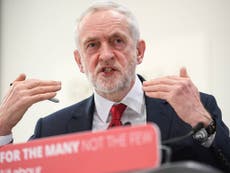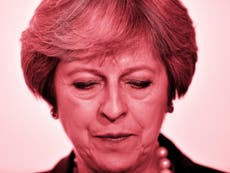Q&A: How a new referendum could happen
Our chief political commentator on the possible scenarios that lead to a new popular vote and how the Brexiteers might try to stop it

The path to a new referendum starts with the EU rejecting Theresa May’s plan for Brexit. Going by all the public comments from Michel Barnier, the EU negotiator, and the leaders of the EU27, it is likely that the EU side will say no to the proposals unveiled at Chequers, because they amount to “cherry picking” the benefits of the single market.
The prime minister then faces a choice between hugging the EU even closer – a customs union and maybe even accepting free movement of people as the price of membership of the single market – or pushing the EU further away. She has been emphatic that she would not accept free movement, although it is possible that a compromise might emerge based on her plan for a “mobility framework”.
However, the pressure on her from the Eurosceptic wing of her party, led by Jacob Rees-Mogg and reinforced by ministerial emigres Boris Johnson, David Davis and Steve Baker, will be intense.
What would hard Brexit look like?
It currently looks more likely that Theresa May would have to fall back on some form of hard Brexit – either a “no-deal deal” to keep the planes flying after Britain leaves in March 2019; or, if the EU agrees, after a transition period lasting until December 2020.
A transition period might allow more preparations to soften the blow, but putting up barriers to trade between the UK and the EU, whenever it happens, is likely to mean short-term disruption and long-term economic costs.
Anticipating this, and with warnings from Amazon and Airbus ringing in their ears, political leaders would further raise the pressure for a new referendum, once it became clear that the choice was between a hard Brexit or remaining in the EU.
Why might Jeremy Corbyn back a referendum?
The prime minister is unlikely to be persuaded that she must hold another referendum. She has staked her mission on implementing the decision of the 2016 vote. But a referendum could be forced on her.
Jeremy Corbyn might see the demand for a referendum as the best way to destabilise the government. His party overwhelmingly supports a new referendum, and he may see the chance to defeat the government in the Commons. His critics say that he would secretly be pleased with any kind of Brexit, hard or soft, but he has made so much of a “jobs-first Brexit” that he could easily switch to a referendum as the way to block an economically damaging Brexit.
If the Labour leadership supported a referendum, it could hope, with the support of pro-EU Conservative MPs, to pass amendments to Brexit legislation to make it happen.
Would there be enough support in parliament?
It would be difficult to defeat the government in the House of Commons. The hard core of five pro-Brexit Labour MPs would be augmented by many others who oppose a second referendum on principle, and who would also ignore Corbyn’s whip. Caroline Flint, the Don Valley MP, for example, has said she would never support a second referendum, saying it is “a mechanism to try to overturn the decision that was taken two years ago”.
So the referendum would need to attract the support of more than the 20 or so usual suspects among pro-EU Tories. It might need 40 or 60 of them, which seems a lot but might be possible if the consequences of a “crash-out” Brexit look serious enough.
Is there enough time for this to happen?
All of this would have to happen rather late in the day, and it would be hard to get the legislation through parliament while the government is in nominal control of the timetable. The referendum itself would have to be held on a severely curtailed timetable in, say, February – the last one took seven months for the legislation (this time there is at least a recent law on the statute book to copy) followed by another four months after David Cameron announced it.
That’s why advocates of a new referendum suggest that the UK should ask the EU for an extension to the Article 50 deadline to allow a referendum on a longer timetable. The EU27 would probably agree to it – after all, they want to see Britain reverse its decision to leave – but would Theresa May’s government ask for it?
What are the chances of any of this happening?
The closer we get to March 2019, the harder it is to predict how the stresses of Brexit might play out. But if we estimate the likelihood of each of the steps towards a new referendum, the probabilities look something like this:
EU rejects Chequers plan 80%
May falls back on hard Brexit 60%
Corbyn supports new referendum 30%
Parliament votes for new referendum 20%
What about the Norway option?
The one kind of Brexit we know the EU would accept would be “Norway plus”, which would mean staying in the single market (accepting free movement) and in a customs union. Although Boris Johnson derides the Chequers plan as Brino (Brexit in name only), it is this plan that would be Brexit in name only.
We would be, in effect, non-voting members of the EU. But it would solve the Irish border problem, and it could be argued that, as long as we are no longer members of the EU, this softest of soft Brexits would honour the close referendum result in 2016.
The problem is that Theresa May is most unlikely to go for it, and nor would any other plausible leader of the Conservative Party. It could only happen if, say, Philip Hammond, the chancellor, or Yvette Cooper, the Labour chair of the Home Affairs Committee, became prime minister of a temporary government of national unity.
Which brings us to the next question.
Couldn’t we have a general election instead?
Jeremy Corbyn might hope to bring the government down and force a general election, but it is hard to see a majority of MPs voting for such a thing. The Fixed-term Parliaments Act requires two-thirds of MPs to vote for an early election, which is even less likely, but the act could be overridden by a new act, passed by a simple majority, setting the date for an election.
Labour and the Scottish National Party would happily vote for an election (the SNP’s ratings have picked up since last year), but the Conservatives would not risk it and the Democratic Unionist Party has promised to support the government (that is what the “confidence” of a confidence and supply deal means).
If there are Conservative MPs who believe a hard Brexit to be against the national interest, it would be easier to persuade them to vote for a referendum than for a new election.
What about a multi-option referendum?
In all of this, I assume that the only kind of referendum would be one that offered a choice between a hard Brexit or no Brexit at all. Justine Greening, the Tory former cabinet minister, has proposed a three-option “preferendum”, asking voters to rank in order of preference the deal, no deal or remain. But if Theresa May can secure any deal with the EU similar to the Chequers blueprint, I think parliament would pass it.
The main chance of a new referendum would be if the country faces a starker choice: essentially a rerun of Leave or Remain, but with Leave meaning a no-deal Brexit with consequences spelt out more clearly than before.
If the consequences of a Brexit deal look dire, a three-way question on a referendum looks more likely.







Join our commenting forum
Join thought-provoking conversations, follow other Independent readers and see their replies
Comments